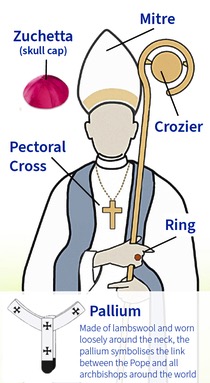What do all the different symbols of being a bishop or archbishop mean?

The ‘signs’ of the bishop’s office are the ring, the mitre and the pastoral staff or crosier. The ring indicates his commitment to be a faithful pastor and shepherd; the mitre is simply a special headdress that is worn during liturgical ceremonies; the crozier represents the shepherd’s crook and reminds the Bishop that he has been appointed to watch over the entire flock of the diocese.
Within every cathedral is the bishop’s chair (or cathedra from which we actually get the word ‘cathedral.’) This has a special significance since the person who sits in this chair is the one who unites this diocese with every other diocese in the universal Church. While we might be the diocese of Adelaide, we are part of the entire Catholic Church, and it is the bishop who is the sign of this unity. (The presider’s chair in each of our parish churches similarly reminds us that through our parish priest we are united to our bishop and through the bishop to the rest of the world.)
Other symbols of the episcopate (the word that refers to being a bishop) are the pectoral cross, the magenta zucchetto (skullcap) and soutane (a type of cassock or gown).
One particular insignia of the office of archbishop is the pallium, a loose white band worn around the neck, made of lamb’s wool and decorated with a black cross on the front and the back, on each shoulder and on the ends of the two strips about 30 cm long that extend down the front and back. The pallium is worn over the chasuble and symbolises the link between the Pope and all the archbishops around the world. It is normally presented to an archbishop by the Pope on the Feast of Sts Peter and Paul (June 29).
There is a long tradition concerning the weaving and blessing of the pallia. Each year on the feast of St Agnes (January 21) two lambs are brought from Tre Fontane, the site of St Paul’s martyrdom, to the Basilica of St Agnes where they are blessed before being presented to the Pope. He in turn hands them over to the care of the Sisters who live next to the Basilica of St Cecilia in Trastevere. Just before Easter, the lambs are shorn and their wool is used to make the pallia for newly-appointed archbishops.
